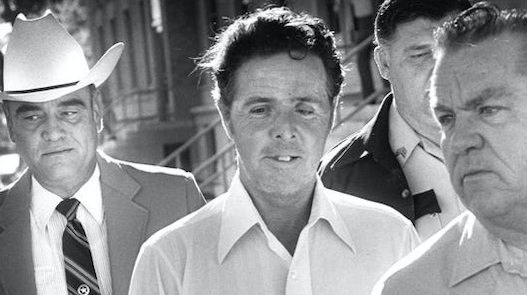
On October 31, 1979, a driver headed north on I-35 near Georgetown, Texas and noticed a body laying in between the highway and the nearby access road. Upon discovering the body, the driver drove to the nearest gas station where he called the Williamson County Sheriff’s Department. When the officials arrived, the body was discovered to be a young nude female, with the only item of clothing and physical evidence being a pair of orange socks. These orange socks would be the only identifier for the young female throughout her investigation.1
Henry Lee Lucas, a man neglected and abused by his mother at a young age, began his life of crime early on in his life. There wasn’t anything he had been charged and arrested for in the past that would amount to the vile acts he would confess to in future years, including confessing to the murder of the Orange Socks girl.2

Leading up to his confession, Lucas had been arrested for the possession of a firearm by a felon and taken to the Montague County Jail. While in custody, Lucas decided he would hand in a previously written statement that entailed the confessions to several murders.3 Within two days of his arrest in Montague County, he began confessing to slews of killings from all over the country. These confessions would, many years later, get him ultimately convicted of ten homicides, and he would be a very strong suspect in over one hundred other homicides.4 Lucas said that there were sixty murders he had added to his confession as a means to get back at the police for arresting him on the firearm charge, which he thought to be a charge made-up by the police. Although Lucas had confessed to many killings, it was his June 1983 confession to the Orange Socks murder that would get him convicted and lead him to become involved in the 1989 court case Lucas v. State of Texas.5
In 1989, the Lucas v State trial commenced, in which Lucas was tried for the murder and rape of the unidentified female in Williamson county, better known as the “orange socks girl.” During the court’s proceedings, psychiatrists, state witnesses, as well as Lucas were put on the stand to testify and be questioned. As the trial came to a close, the defense brought in an expert psychologist and psychiatrist to give their testimony regarding the evaluations they had previously conducted on Lucas. The expert psychologist Dr. Tom Kubiszyn conducted his psychological evaluations on February 28 and 29 of 1984, lasting about seven hours each, and from these evaluations Kubiszyn testified that Lucas, “has an IQ in the low average or normal range, with strong feelings of inadequacy and inferiority, of evasiveness and suspiciousness.”6 Kubiszyn also diagnosed Lucas as being schizophrenic while having some qualities of a sociopathic disorder. The expert psychiatrist Dr. Jay Fogelman had conducted five interviews with Lucas where he gained information from Lucas about himself. From these interviews Fogelman came to the same conclusion as Kubiszyn in that Lucas was suffering from some form of schizophrenia that needed treatment, as well as that he may have an antisocial personality. Both Kubiszyn and Fogelman said that Lucas was not only suffering from the previously mentioned schizophrenia, but that he was also a dangerous individual based on his history of previous violence.7
When the issue of his right to an attorney arose for Lucas, he tried to claim that he was denied his right to counsel guaranteed to him in the sixth amendment. But it was also noted that he did not go against the statements given by the state witnesses and understood that he would not receive counsel and did not want an attorney present. Later, against the advice of his various attorneys to remain silent and implement discretion, Lucas chose to do the opposite and he had appeared “…to have been determined to speak to the authorities desiring his attention. In what may be best termed a single-minded purpose, he appears to have rejected his right to remain silent and put the State to its burden of proving a particular crime…..appellant made what can only be termed a conscious practice of informing on himself as to crimes which, up until that point in time, remained unsolved.” In this same scenario, Lucas claimed he only wanted to talk about where the bodies were, as long as someone listened and was determined to only confess to his “criminal conduct” based on his desires and terms.8

As the trial continued, Lucas described the incident in his words. Lucas described the Jane Doe has having refused to engage in intercourse with him and of having tried to jump out of the moving vehicle. Lucas claimed she grabbed hold of the steering wheel, and that he grabbed her in a motion to try and stop her attempt to escape, while she fought against him. This action caused by the deceased was thought to Lucas as a sufficient reason to handle her in such a manner since it could’ve resulted in a car accident and in his own demise. The court did not find this evidence and information useful in the incident that the deceased was trying to provoke violence from Lucas or to incite him. Despite this information and the details coming solely from Lucas, who would’ve been present for the crime, the court did not find any information that corroborated that Lucas had any desire or intention to release Jane Doe alive. Based on this notion, it was derived that Lucas killed the deceased not based on the passion in the heat of the moment, but from careful calculation.9
Based on all the relevant information and testimony given by the state’s witnesses, expert psychiatrist and psychologists, as well as Lucas’ own testimony, the court reached a verdict in the Lucas v. State trial. The verdict reached was guilty on the capital murder charge on Lucas, and he was given a life sentence in prison for his crime. Being as Lucas was being convicted on a capital murder charge—the highest offense one can commit—meant that he was being sentenced to death and would be put on death row.10 Lucas was to serve out his sentence in a facility in Texas for the remaining time of his life.11
Going back to the years prior to his conviction, starting in 1983, around the time of his orange socks confession, Lucas had been interviewed by around 600 different law enforcement agencies. Through these interviews about open cases, police were gaining useful information, and cleared roughly 210 homicide cases. But since these case closures were directly attribute to Lucas, he began bragging about how he was the one getting cases close, not the law enforcement agencies.12 This combined attention and the fact that he believed he was exhibiting retribution against police on the “made-up” firearm charge, could’ve led to why he chose to confess to the orange socks murder and the hundreds of others.
Lucas remained on death row until 1998. At that time, the then-governor of Texas George W. Bush cited that there was a lack of evidence linking Lucas to the murder of the then unidentified “orange socks” woman other than his confession, and removed his death sentence. This was the only time governor Bush would allow such a situation to occur. Having his death sentence removed, but his life in prison sentence still intact, Lucas remained in prison until his death in 2001 from a heart attack.13

After significant investigation, interviews and verification through familial DNA testing, the unidentified woman, who was known as “Orange Socks,” was identified. In 2019, almost forty years after her brutal murder and rape, the individual was identified as being Debra Jackson, from Abilene, Texas, and she was only twenty-three years old at the time of her untimely death. It was believed that Jackson had left her home in 1977, two years prior to her interaction with Lucas, and was not initially reported missing by her family.14
- Lucas v. State, 791 S.W.2d 35 (Tex. Crim. App. 1989), 40. ↵
- Steven A. Egger, The Killers Among Us: An Examination of Serial Murder and Its Investigation (New Jersey: Prentice Hall, 1998), 169. ↵
- Lucas v. State, 791 S.W.2d 35 (Tex. Crim. App. 1989), 41. ↵
- Steven A. Egger, The Killers Among Us: An Examination of Serial Murder and Its Investigation (New Jersey: Prentice Hall, 1998), 11. ↵
- Gisli Gudjonsson PhD, “The making of a serial false confessor: The confessions of Henry Lee Lucas,” The Journal of Forensic Psychiatry, 10:2 (1999): 416-426, DOI: 10.1080/09585189908403693 418, 421. ↵
- Lucas v. State, 791 S.W.2d 35 (Tex. Crim. App. 1989), 43. ↵
- Lucas v. State, 791 S.W.2d 35 (Tex. Crim. App. 1989), 43. ↵
- Lucas v. State, 791 S.W.2d 35 (Tex. Crim. App. 1989), 49. ↵
- Lucas v. State, 791 S.W.2d 35 (Tex. Crim. App. 1989), 65. ↵
- Content Team. “Capital Murder – Definition, Examples, Meaning, Cases, and Sentences.” Legal Dictionary, (February 15, 2019). https://legaldictionary.net/capital-murder/. ↵
- Gajanan Mahita, “The Story Behind the Netflix Series ‘The Confession Killer,’” Time, (December 6, 2019). https://time.com/5745028/the-confession-killer-henry-lee-lucas-netflix/. ↵
- Steven A. Egger, The Killers Among Us: An Examination of Serial Murder and Its Investigation (New Jersey: Prentice Hall, 1998), 172, 207. ↵
- Gajanan Mahita, “The Story Behind the Netflix Series ‘The Confession Killer,'” Time, (December 6, 2019). https://time.com/5745028/the-confession-killer-henry-lee-lucas-netflix/. ↵
- Abigail Arredondo, “Who Was Debra Jackson, the ‘Orange Socks’ Cold Case Victim?” KVUE, (August 8, 2019). https://www.kvue.com/article/news/local/who-was-debra-jackson-the-orange-socks-cold-case-victim/269-e7073ddd-14a5-4221-b223-27ae29f7f2c7. ↵



63 comments
Arsema Abera
This was a fascinating and creepy article. Lucas was clearly mental and had some troubles but what I didn’t really understand was why would he confess to such crimes out of the blue, and he isn’t like most murders like killing people for passion or just for the fun of it. In the end, it is a really sad story he didn’t at least die in an electric chair or whatever but died of natural causes which I could say is better than the former.
Amanda Shoemaker
I recently watched ‘The Confession Killer’ which was a documentary entirely about Henry Lee Lucas. This article does a good job of telling more about him but I know that there’s a lot more dark and crazy things about this man and his life. Although, I wasn’t aware the George Bush was the one that removed his death sentence. His story is overall a very, very sad story.
Aracely Beltran
It is really sad that people are this evil out there, even though justice was served the families are never going to get their loved one back. He ripped people from their home and took pride in this. It is truly disturbing. I wonder at how many bodies he would’ve been at if the body of the female with the orange socks wasn’t found.
Luis Jaen
This is such an interesting and scary article. It is crazy to think that people like Lucas think nothing of what they do and the pain they instill on others. It is interesting to observe that a lot of people who do things like this have a history of being unloved or loved incorrectly. Although that is not an excuse, the background of someone could explain why these things happen and how they are carried out. The most bizarre thing about this article is that Lucas was interviewed by over SIX HUNDRED law enforcement agencies. Overall, this article is a great read with a very interesting topic.
Kennedy Arcos
I found this to be a really interesting story. It’s crazy how he just confessed to all of these killings and I can’t believe he got away with so many murders. It’s super upsetting to think about how this young girl went out and never made it back home. Another thing I find crazy is how this sporty took place in Texas, where I am from.
Melanie Fraire
It was disturbing to read about how much pride he took in all his murders and how he confessed as if it were no big deal however, it was good to read that justice was served for all the murders he committed. Another thing that shocked me was towards the end when you mentioned how she wasn’t identified until almost 40 years later.
Giselle Garcia
This was a very interesting case and I thought it was crazy for the murderer to confess to his crime because I thought they would want to get away with it. It’s sad that a young girl was murdered but the killer was punished by serving his time in prison. It’s crazy that Lucas wanted to confess because he sought attention and believed he was in control of the cases.
Micheala Whitfield
I always enjoy stories such as these. In this article you make the emphasis on how he was in control of his whole demise. This man got away with over a 100 homicides and the police caught him on a firearm charge. His response to the charge was to up the stakes and confess to multiple murders. All because he wanted the attention and control of the situation. To blame the police would also not be sufficient to him. Back in that decade, technology was not as advanced as today and availability to material/equipment would either be expensive or take a while to process. If he was processed today he might have been charged for more. Still ending in the same sentencing. Especially here in Texas. It definitely makes you wonder though, there are constantly people getting away with murder, why is the system so flawed and will it ever become easier?
Jose Chaman
Incredibly, most serial killers have a very dark history during their childhood. This article presents the story of Henry Lee Lucas, a serial killer who is known for the murder or case of “The Orange Socks Girl”. It really seemed brutal to me what Lee did, and I am sad that these kinds of situations occurred and They occur in the world. Luckily, our society has developed a system with which we can identify these cases prematurely and thus avoid further complications.
Andrea Degollado
I think articles such as these are always fascinating to read. Something that I noticed while reading Lucas case was that comparing it to other cases these killers have many similarities. They all have been unwanted by their family or have some sort of “disease.” However reading this articles is heartbreaking, reading abut young girls,such as Debra, that go out one night not knowing it will be their last. In my opinion Lucas serving his whole like in jail is a better punishment then death.